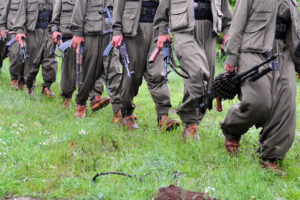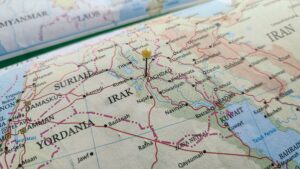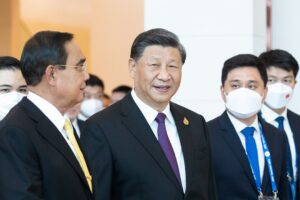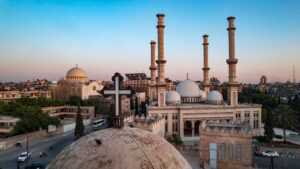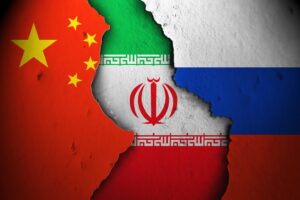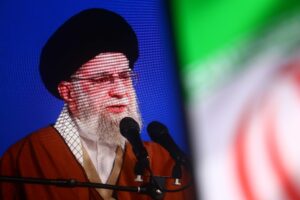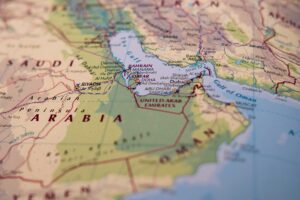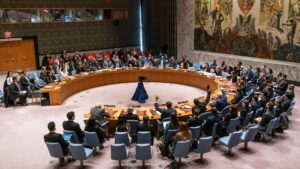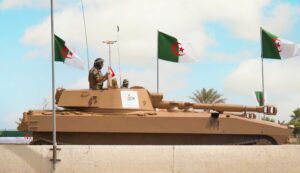For Algeria, February 22, 2019, marked ordinary citizens’ return as central actors of the political scene. From the capital Algiers in the North to the oasis city of Tamanrasset in the South, massive crowds have taken up to the streets to protest against President Abdelaziz Bouteflika’s fifth term and ask for radical change. Aerial photos of this anti-government, anti-system Hirak [movement], with an intimidating sea of people pacifically demonstrating every week, surprised the world. Born spontaneously from Algerians’ desire to reclaim their voice, public space, and citizenship, the movement opted for non-violence and proved its civic responsibility. Last April, the movement halted its marches to respect the government restrictions to fight the Covid-19 pandemic and put in place solidarity networks to help the most vulnerable groups.
However, the fervent political energy that I felt in the streets of Algiers[1] in the first months has been, unfortunately, disproportionate with the tangible results of these demonstrations. No significant change happened in the too well-oiled system and the too resilient and adaptive regime.[2] The movement has shown its mobilization potential, raised awareness, and changed public opinion nationwide and internationally. However, it could not action any genuine institutional change or impact the electoral process as presidential elections and a referendum on a new constitution took place on December 12, 2019 and November 1, 2020 respectively.
The movements’ relative lack of success in terms of achievements can be explained by its impracticable demands, absence of leadership, and the regime’s strategy to self-restrain and use calibrated coercion.
“Unrealistic Demands”[3]
A key reason for the low success of the movement to achieve tangible results is the inexistence of workable goals and the absence of a clear roadmap for “the day after.” Moreover, there was no plan to keep protesters engaged and integrate them into the political process.
Defining features of the opposition have been the mass mobilization every Friday in the 48 wilayas (departments) that constitute the country, which have been highly pacific in nature (i.e., no violence from the protesters, establishing vigil committees to protect women and children) and characterized by civic behaviors (such as collecting trash, cleaning up the streets after each demonstration). Despite the solidarity (distribution of food and water), despite hours spent in the streets of the country in the heat and under the rain, the demonstrations quest to have “no elections,” “a civilian state and not a military one” and to oust all politicians “ Yetnahew Gaâ’” did not materialize and has little to no chance to do so because they are simply unworkable.
While it is true that President Abdelaziz Bouteflika resigned and more than 100 senior government officials and business tycoons close to him were arrested, the election was postponed twice on April 18 and July 4. It is also beyond argument that this was the Hirak’s latest “victory.” Since then, it has proved unable to call off the election altogether, as elections were neither fair nor transparent and allowed the system to regenerate itself. On December 12, the presidential election took place despite popular resistance, and Abdelmadjid Tebboune, the army’s choice, was “elected” president.
At their head was then-Deputy Minister of Defense and Chief of Staff Ahmed Gaïd Salah, the military piloted the “succession” and returned behind the scenes to continue ruling the country. Finally, all ministers and the new parliament were selected from an elite that has been recycled repeatedly to support the military establishment and the ruling elite’s decision-making. Today, despite Tebboune’s lack of legitimacy and unpopularity — as evidenced by low voter turnout at his election and the referendum on the new constitution that he proposed[4] — his position is not threatened as the military stands behind him.
Moreover, it is the Hirak that is showing signs of vulnerability with a serious durable confrontation between two groups: the first with impracticable and unfeasible demands: the Forces du pacte de l’alternative démocratique (Forces of the Democratic Alternative Pact), who refuses any discussion with the authorities and call for a total dissolution of the “system” and a constituent assembly that would eventually lead to a democratic transition. The second is the Pôle démocratique (Democratic Pole), which calls for negotiating with the authorities to reach a consensus and whose representative backed up the National Dialogue Commission, led by diplomat Karim Younes, which dissolved.
Absence of Leadership
Another reason to explain why the popular movement has achieved so little is to be found in its absence of leadership. Men and women, young and old, individuals with different socioeconomic backgrounds, participated without any formal affiliation with neither a hierarchy nor a leader at every Friday demonstration. Social networks, mainly Facebook and Twitter, helped virtually replicate the Hirak’s modus operandi everywhere with its basic patterns: marching, chanting, interacting with the authorities, communicating with the media, etc. The same message echoed all over Algeria: “no to the fifth term,” “no to elections,” “Yetnahew Gaâ” [They all leave], and “No to a military state.”
Algerians refused all kinds of leadership to their movement. The latter has a horizontal structure and no official spokesperson. They refuse to appoint leaders fearing the classic strategies of demonization, marginalization, and co-optation used by the regime. They also remember the Kabyle’s citizen movement or the Aârouch in 2001 that developed good bargaining power and that managed to extract concessions (i.e., Tamazight’s recognition as a national language in the constitution). Nevertheless, the movement eventually lost momentum for several reasons, mainly due to the regime’s manipulation and ability to co-opt its leaders. As such, protesters refused to name leaders who will look at their interests and empty the movement from its mobilization potential and meaning.
Some individuals, such as opinion leader Karim Tabou and human rights lawyer Mustapha Bouchachi, through their charisma and their moral capital, succeeded in creating their authority but without fully embracing it as they refused to endorse any leadership position officially. Nevertheless, whether it is desired or not, leadership matters, not only to create a clear hierarchical chain of command but also a well-oiled and permanent organization that can continue to build and sustain the movement. Leadership also gives the movement credibility to sit at the negotiation table to continue the political work that creates real change.
Change requires sustained political organizing. Clicktivism[5] might be sufficient to ignite political energy but infrastructures are needed to channel that energy and translate it into public policies. As explained by Zeynep Tufekci in the case of the Gezi protests in 2014 in Turkey: “Before the Internet, the tedious work of organizing […] also helped build infrastructure for decision making and strategies for sustaining momentum. Now movements can rush past that step, often to their own detriment.”[6]
Behaved Security Forces
In the beginning, the primary catalyst of the protests was the overreaction of the Algerian authorities. The Deputy Minister of National Defense and Chief-of-Staff Ahmed Gaïd Salah warned Algerians against “suspicious calls for mobilization in the name of democracy,” insisting that the Army stand up against all those who would undermine the stability of the country.[7] Days later, on March 7, then-President Bouteflika himself warned against “insidious” enemies and those “who conspire” and want to propagate “chaos.” On the streets, police used tear gas, and demonstrators were detained. This immediately placed the events in a traumatic historical frame: Algiers’s October 5, 1988 crackdown on protesters. During these events, the army intervened and shot on sight. The official death toll stood at 176 while unofficial estimates stood at 500. The regime lost its already meager legitimacy despite the political reforms that it engaged in 1989 with a new constitution and a multiparty system.
However, in the following weeks the authorities quickly came to understand that a crackdown would be a poor strategy. Except on a few occasions, the police behaved calmly and with patience throughout the country. For a year, violence from the security forces was an exception rather than the rule. The authorities let protesters vent their anger, ceded many parts of the city for demonstrations, and La Grande Poste became a landmark for protesters. President Tebboune himself validated their grievances and described their movement as “blessed” because it “saved the Algerian state from an announced collapse.”[8]
Entering in a confrontation and crashing demonstrators openly is not the strategy of the authorities, at least until now. Instead, they are using more subtle tactics such as legal means, blackmailing, demonization, co-optation, and infiltration to silence the last dissenting voices. This deprives the movement of its mobilization potential, demoralizes followers, and the Hirak risks petering out over Algeria’s long Covid-19 confinement. However, the fear of a bloody confrontation is still present because hardliners exist on both sides. From the movement’s side, there are always people who believe that violence is the only solution. In contrast, others might radicalize due to their pauperization following the catastrophic social and economic fallout caused by the Covid-19 crisis. From the authorities’ side, as the socio-economic situation worsens, the use of repression remains an option if their calculus leads them to conclude that the costs of toleration are higher than those of repression.
Conclusion
Despite the Hirak’s few tangible successes, one thing remains sure: there is before and after February 22, 2019. First, the Hirak succeeded in raising awareness. Using Google Trends data comparing Google search behavior throughout 2019, it does seem that more individuals in Algeria were interrogating the events that were unfolding, with searches such as “constitution,” “article 8″[9], “demonstration” or interrogating the identities of those close to the Bouteflika clan such as the businessman Ali Haddad. All these are words that have been central to the Hirak in the first weeks of the protests. As shown below, all these words have seen sharp upticks in interest between February 24 and April 6, 2019.
Second, the Hirak raised awareness and pushed people to show their mobilization potential and demonstrate a new relationship with politics, which one can expect to modify political action forms. New organizations, associations, discussion forums and local committees have emerged from the Hirak to introduce the foundation for a genuine democracy and transition demand.
As a result of this change of consciousness and behavior, Algerians took up to the streets, repudiated their president and their government, as well as having denounced unanimously corruption and military involvement in politics. This will have a lasting impact because even if many leaders survived, their revolutionary and political legitimacy died. Furthermore, despite the regime’s survival, it seems that Algerians are not going to be easily bent. The systemic problems that Algeria will be facing – fiscal, economic, and social – in the upcoming months will give this new generation of dissidents enough ammunition to fight their next battle of Algiers.
1. D. Ghanem, 2019, ‘A Protest Made In Algeria’, Carnegie Middle East Center, https://carnegie-mec.org/2019/04/02/protest-made-in-algeria-pub-78748
2. For more on the elements behind the longevity of the Algerian regime and its capacity to whether crisis, see D. Ghanem, 2018, ‘Limiting Change Through Change: The Key to the Algerian Regime’s Longevity’, Carnegie Middle East Center, https://carnegie-mec.org/2018/05/08/limiting-change-through-change-key-to-algerian-regime-s-longevity-pub-76237
3. This is how many Algerians to whom I spoke for this article described the demands of the hirak. Some of them used the term “idealistic” while other chose to speak about “ unworkable” demands.
4. At the presidential election, the abstention rate reached 58 percent against 76 percent in the referendum for the new constitution.
5. What is clicktivism, http://www.clicktivist.org/what-is-clicktivism/
6. Z. Tufekci, 2014, ‘After the Protests’, The New York Times, https://www.nytimes.com/2014/03/20/opinion/after-the-protests.html?_r=0
7. Original quote: “l’ANP se dresserait en rempart contre tous ceux qui voudraient attenter à la stabilité du pays.” Mokrane Ait Ourabi, Situation politique et manifestations de rue : Le ton instable d’Ahmed Gaïd Salah [“Political situation and street protests: The unstable tone of Ahmed Gaïd Salah”], El watan, March 7, 2019.
8. APS, Le Hirak peut alimenter un système de veille et donner naissance à une nouvelle société civile [The Hirak Can Feed a Monitoring System and Give Birth to a New Civil Society], February 18, 2020. http://www.aps.dz/algerie/101807-belhimer-le-hirak-peut-alimenter-un-systeme-de-veille-et-donner-naissance-a-une-nouvelle-societe-civile
9. A reference to Article 8 of the Algerian Constitution, which states that “Constituent power belongs to the people.”


